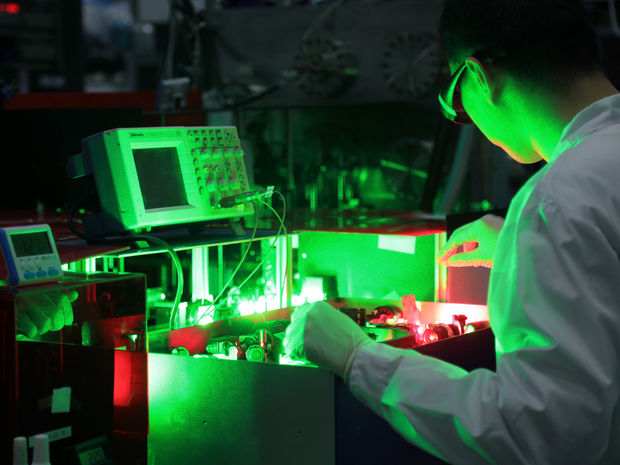Toxin detection as close as an inkjet printer
If that office inkjet printer has become just another fixture, it's time to take a fresh look at it. Similar technology may soon be used to develop paper-based biosensors that can detect certain harmful toxins that can cause food poisoning or be used as bioterrorism agents.
In a paper published in the July issue of Analytical Chemistry, John Brennan and his research team at McMaster University, working with the Sentinel Bioactive Paper Network, describe a method for printing a toxin-detecting biosensor on paper using a FujiFilm Dimatix Materials Printer.
The researchers demonstrated the concept on the detection of acetylcholinesterase (AChE) inhibitors such as paraoxon and aflatoxin B1 on paper using a "lateral flow" sensing approach similar to that used in a home pregnancy test strip.
The process involves formulating an ink like the one found in computer printer cartridges but with special additives to make the ink biocompatible. An ink comprised of biocompatible silica nanoparticles is first deposited on paper, followed by a second ink containing the enzyme, and the resulting bio-ink forms a thin film of enzyme that is entrapped in the silica on paper. When the enzyme is exposed to a toxin, reporter molecules in the ink change colour in a manner that is dependent on the concentration of the toxin in the sample.
This simple and cost-effective method of adhering biochemical reagents to paper is expected to bring the concept of bioactive paper a significant step closer to commercialization. The goal for bioactive paper is to provide a rapid, portable, disposable and inexpensive way of detecting harmful substances, including toxins, pathogens and viruses, without the need for sophisticated instrumentation. The research showed that the printed enzyme retains full activity for at least two months when stored properly, suggesting that such sensor strips should have a good shelf life.
Portable bio-sensing papers are expected to be extremely useful in monitoring environmental and food-based toxins, as well as in remote settings in less industrialized countries where simple bioassays are essential for the first stages of detecting disease.
Applications for bioactive paper also include clinical applications in neuroscience, drug assessment, and pharmaceutical development.
Topics
Organizations
Other news from the department science
These products might interest you

NANOPHOX CS by Sympatec
Particle size analysis in the nano range: Analyzing high concentrations with ease
Reliable results without time-consuming sample preparation

Eclipse by Wyatt Technology
FFF-MALS system for separation and characterization of macromolecules and nanoparticles
The latest and most innovative FFF system designed for highest usability, robustness and data quality

DynaPro Plate Reader III by Wyatt Technology
Screening of biopharmaceuticals and proteins with high-throughput dynamic light scattering (DLS)
Efficiently characterize your sample quality and stability from lead discovery to quality control

Get the chemical industry in your inbox
By submitting this form you agree that LUMITOS AG will send you the newsletter(s) selected above by email. Your data will not be passed on to third parties. Your data will be stored and processed in accordance with our data protection regulations. LUMITOS may contact you by email for the purpose of advertising or market and opinion surveys. You can revoke your consent at any time without giving reasons to LUMITOS AG, Ernst-Augustin-Str. 2, 12489 Berlin, Germany or by e-mail at revoke@lumitos.com with effect for the future. In addition, each email contains a link to unsubscribe from the corresponding newsletter.
Most read news
More news from our other portals
See the theme worlds for related content
Topic world Sensor technology
Sensor technology has revolutionized the chemical industry by providing accurate, timely and reliable data across a wide range of processes. From monitoring critical parameters in production lines to early detection of potential malfunctions or hazards, sensors are the silent sentinels that ensure quality, efficiency and safety.

Topic world Sensor technology
Sensor technology has revolutionized the chemical industry by providing accurate, timely and reliable data across a wide range of processes. From monitoring critical parameters in production lines to early detection of potential malfunctions or hazards, sensors are the silent sentinels that ensure quality, efficiency and safety.
Last viewed contents
ANGUS to withdraw sales of nitrofuels outside of the US
LANXESS increases prices for technical rubber grades
LamdaGen's Catalytic Nanotechnology Integrated into Biodiesel R&D Programs in Biodico Collaboration
BASF and Toray form joint venture for PBT production in Asia

Analytik Jena AG with New Managing Director at French Subsidiary



























































